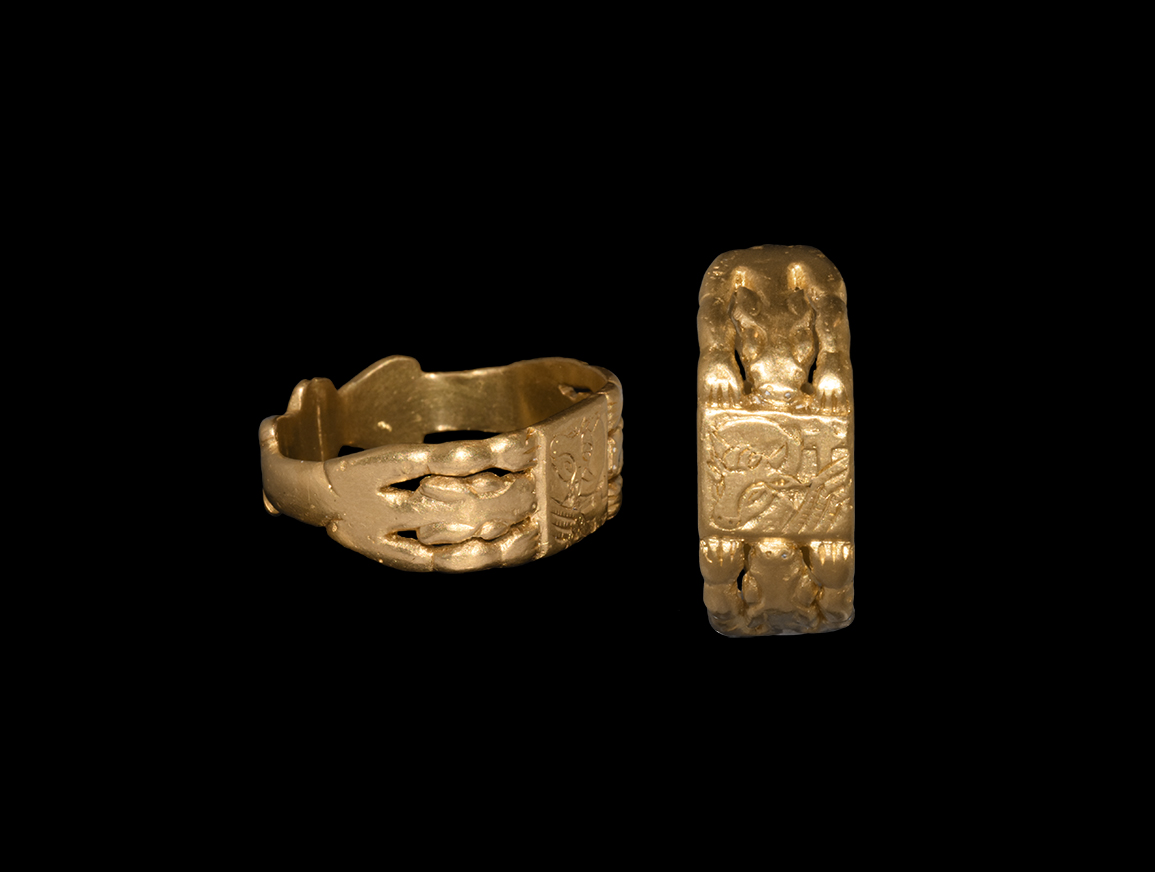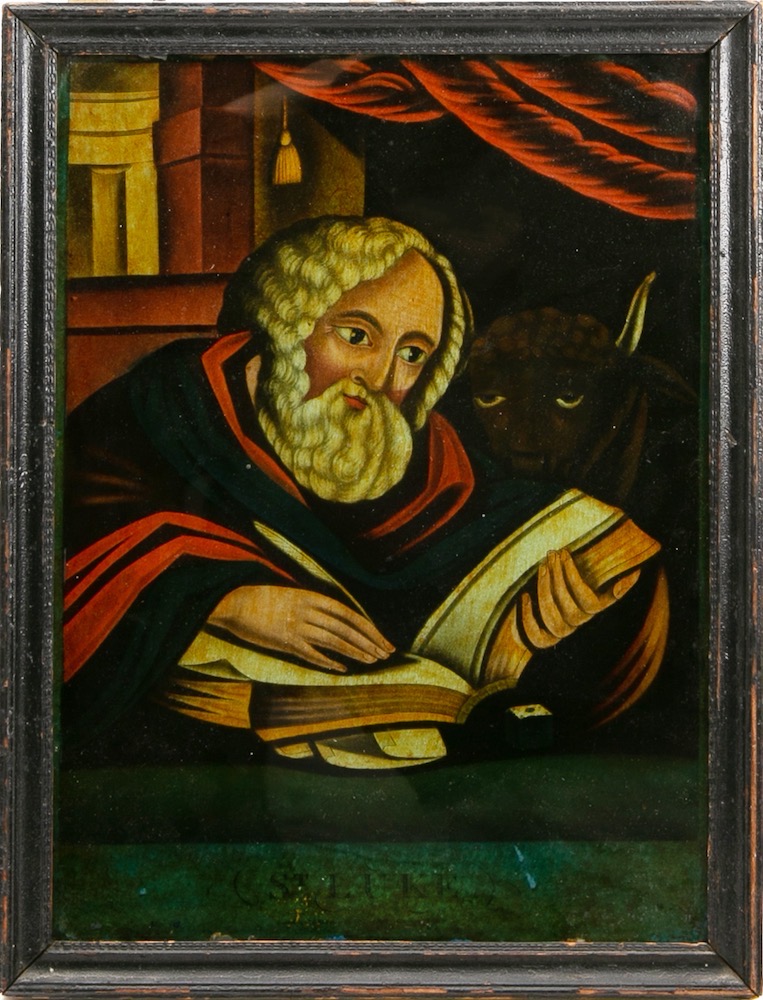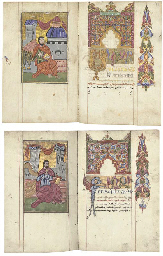GOSPEL OF ST LUKE, glossed, in Latin, MANUSCRIPT ON VELLUM [northern France, mid-12th century] 230 x 163mm. 83 leaves: 1 7 (of 8, lacking iii), 2-10 8 , 11 4 , quire numbers on final versos of gatherings vii and x, 23 lines of biblical text and up to 50 lines of gloss written in brown ink in a protogothic bookhand between two inner pairs and two outer single verticals and up to 48 horizontals ruled in plummet, capitals touched red, rubrics, running headings and chapter numbers and explicit in red (waterstaining to outer upper corner of first two leaves and spotting to final two leaves). French 18th-century mottled calf gilt, flat spine gilt with lettering-piece in French (repairs at spine and corners). PROVENANCE: 1. Whether written for a cathedral school or monastery, modifications -- such as the change to the chapter numbering of the running headings -- and various sidenotes show that the manuscript continued in use up to the 16th century. 2. Nicolas de ?Feustdem: inscription in a 16th-century hand at the head of folio 76v reading 'Nicolas de ?Feustdem a l'abbae Monsieur St Eloi le noion'. This is presumably the Benedictine Abbey of St Eloi in Noyon that was destroyed by the Calvinists in 1591. 3. Jacques Lemaire ownership inscription at the head of folio 50v reading 'Ce present livre appartiene a jaque lemaire'. 4. Bookplate of G.H.J. and A.J. of Trewithan, 1933 inside upper cover. CONTENT: Chapter summaries ff.1v-2; Preface to the Gospel of Luke, lacking end ff.2v; Gospel of St Luke with gloss, lacking opening ff.3-83v. The composition of a standard gloss -- the Gloss or Glossa Ordinaria -- for all the books of the Bible has been described as one of the supreme achievements of the cathedral schools of northern France. Principally compiled by Anselm of Laon (d.1117) with the assistance of his brother Ralph (d.1133) and Gilbert of Auxerre (d.1134), who was probably responsible for the gloss on the Gospel of St Luke, the process was complete by around 1135, and a set of explanatory quotations from the church fathers was current for every book of the Bible. During the third quarter of the 12th century a sophisticated page layout was developed where biblical text and gloss were integrated into a unified ruling-pattern, the format adjusted from page to page according to the relative length of text to gloss, in order to avoid gaps and blank areas. This type of layout was almost universally adopted from around 1170 and the fact that the present manuscript doesn't follow this pattern indicates its earlier date. Here each page has been uniformly ruled to carry the biblical text in a central column, lines of gloss written where appropriate to either side or even, if necessary, above and below. Antedating the standardisation of chapter divisions, the numbering of the running headings and the summaries on folios 1v-2 relate to a division of Luke's Gospel into only twenty chapters. Even these are additions to the original scheme, for the text was written continuously with no subdivision into chapters.
GOSPEL OF ST LUKE, glossed, in Latin, MANUSCRIPT ON VELLUM [northern France, mid-12th century] 230 x 163mm. 83 leaves: 1 7 (of 8, lacking iii), 2-10 8 , 11 4 , quire numbers on final versos of gatherings vii and x, 23 lines of biblical text and up to 50 lines of gloss written in brown ink in a protogothic bookhand between two inner pairs and two outer single verticals and up to 48 horizontals ruled in plummet, capitals touched red, rubrics, running headings and chapter numbers and explicit in red (waterstaining to outer upper corner of first two leaves and spotting to final two leaves). French 18th-century mottled calf gilt, flat spine gilt with lettering-piece in French (repairs at spine and corners). PROVENANCE: 1. Whether written for a cathedral school or monastery, modifications -- such as the change to the chapter numbering of the running headings -- and various sidenotes show that the manuscript continued in use up to the 16th century. 2. Nicolas de ?Feustdem: inscription in a 16th-century hand at the head of folio 76v reading 'Nicolas de ?Feustdem a l'abbae Monsieur St Eloi le noion'. This is presumably the Benedictine Abbey of St Eloi in Noyon that was destroyed by the Calvinists in 1591. 3. Jacques Lemaire ownership inscription at the head of folio 50v reading 'Ce present livre appartiene a jaque lemaire'. 4. Bookplate of G.H.J. and A.J. of Trewithan, 1933 inside upper cover. CONTENT: Chapter summaries ff.1v-2; Preface to the Gospel of Luke, lacking end ff.2v; Gospel of St Luke with gloss, lacking opening ff.3-83v. The composition of a standard gloss -- the Gloss or Glossa Ordinaria -- for all the books of the Bible has been described as one of the supreme achievements of the cathedral schools of northern France. Principally compiled by Anselm of Laon (d.1117) with the assistance of his brother Ralph (d.1133) and Gilbert of Auxerre (d.1134), who was probably responsible for the gloss on the Gospel of St Luke, the process was complete by around 1135, and a set of explanatory quotations from the church fathers was current for every book of the Bible. During the third quarter of the 12th century a sophisticated page layout was developed where biblical text and gloss were integrated into a unified ruling-pattern, the format adjusted from page to page according to the relative length of text to gloss, in order to avoid gaps and blank areas. This type of layout was almost universally adopted from around 1170 and the fact that the present manuscript doesn't follow this pattern indicates its earlier date. Here each page has been uniformly ruled to carry the biblical text in a central column, lines of gloss written where appropriate to either side or even, if necessary, above and below. Antedating the standardisation of chapter divisions, the numbering of the running headings and the summaries on folios 1v-2 relate to a division of Luke's Gospel into only twenty chapters. Even these are additions to the original scheme, for the text was written continuously with no subdivision into chapters.









.jpg)
.jpg)



Try LotSearch and its premium features for 7 days - without any costs!
Be notified automatically about new items in upcoming auctions.
Create an alert